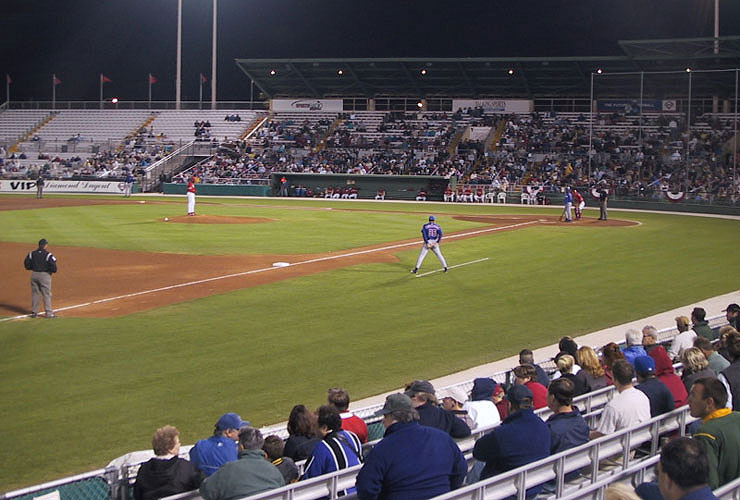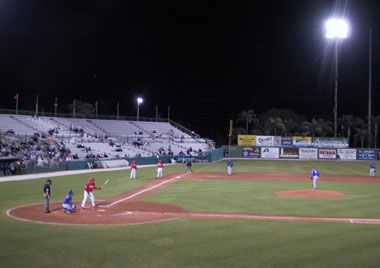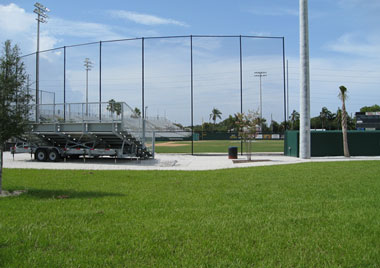
|
For 49 spring trainings the Philadelphia Phillies called Jack Russell Stadium their Grapefruit League home. Their tenure there was one of the longest ever by a team at the same spring training stadium.
Planning for the stadium began in 1954, when architects Roy Wakeling of Clearwater and Marr & Holman of Nashville jointly designed "a stadium built on the cantilever principal eliminating all obstructing posts." Completed at a cost of $317,653, the stadium was financed through recreation revenue certificates that were to be paid back over 30 years, primarily through game receipts and concessions. The stadium's original capacity was 4,716 and the city of Clearwater received 10% of the gate receipts when the Phillies held their first spring training there in 1955. The stadium was championed by city commissioner Jack Russell, the chairman of the city's baseball committee and a former big league pitcher who won 85 games over his career, which began in 1926 and included a selection to the 1934 American League All-Star team. In his honor, the ballpark was dedicated as Jack Russell Stadium when it opened on March 10, 1955 during a pre-game ceremony attended by baseball commissioner Ford Frick. The Phillies beat the Tigers in the game that followed by a score of 4-2. A crowd of 4,209 attended that inaugural game and none of them drank a beer. The sale of alcohol wasn't allowed inside of the stadium until 1977. For the first 29 years of its existence, Jack Russell Stadium was better known as the home field of the Clearwater Bombers, a men's fastpitch softball team of national prominence, than it was as the winter home of the Phillies. The Bombers won 10 Amateur Softball Association (ASA) national championships during their rent free occupancy at Jack Russell Stadium, which they were forced out of in 1985 by the Clearwater Phillies, a team in the Class A Florida State League. During the Clearwater Phillies inaugural season the stadium's organist, Wilbur Snapp, was thrown out of a game for playing “Three Blind Mice” after a close call at first base went against the home team. His ejection on June 26, 1985 marked the only time in baseball history that an umpire ejected an organist. Over the years the stadium's capacity expanded, but the majority of its seats were always metal bleachers. The continuous grandstand stretched well down the left field line to a short distance past first base, where a two story clubhouse was added. The Phillies - both the Clearwater and Philadelphia teams - played their final games at Jack Russell Stadium in 2003. The following season each moved to Bright House Field, which was built four miles away. Upon relocating, the Clearwater team changed its name to the Threshers. Although Jack Russell Stadium was never especially noted for its aesthetic beauty, it was home to a small tiki bar in its latter years. That tiki bar would be the inspiration for the popular Frenchy's Tiki Pavilion in its successor. While Bright House Field was built alongside a major highway, Jack Russell Stadium had a much more residential location. But over the years the neighborhood that surrounded the stadium became run down, limiting the appeal of it for future use. On July 21, 2007 most of Jack Russell Stadium was demolished after the Clearwater City Council paid $104,280 to JVS Contracting of Tampa to tear down the majority of the grandstand. Bleacher sections down each outfield line, both dugouts and the Phillies clubhouse were left standing. Today the clubhouse is the office of The Winning Inning, a local baseball training academy that uses the field to instruct youth players. The field is also used for amateur games, including the inaugural Big East/Big Ten Baseball Challenge that took place February 20-22, 2009.

Jack Russell Stadium Facts, Figures & Footnotes
| ||||||||||||||||||||||||||


